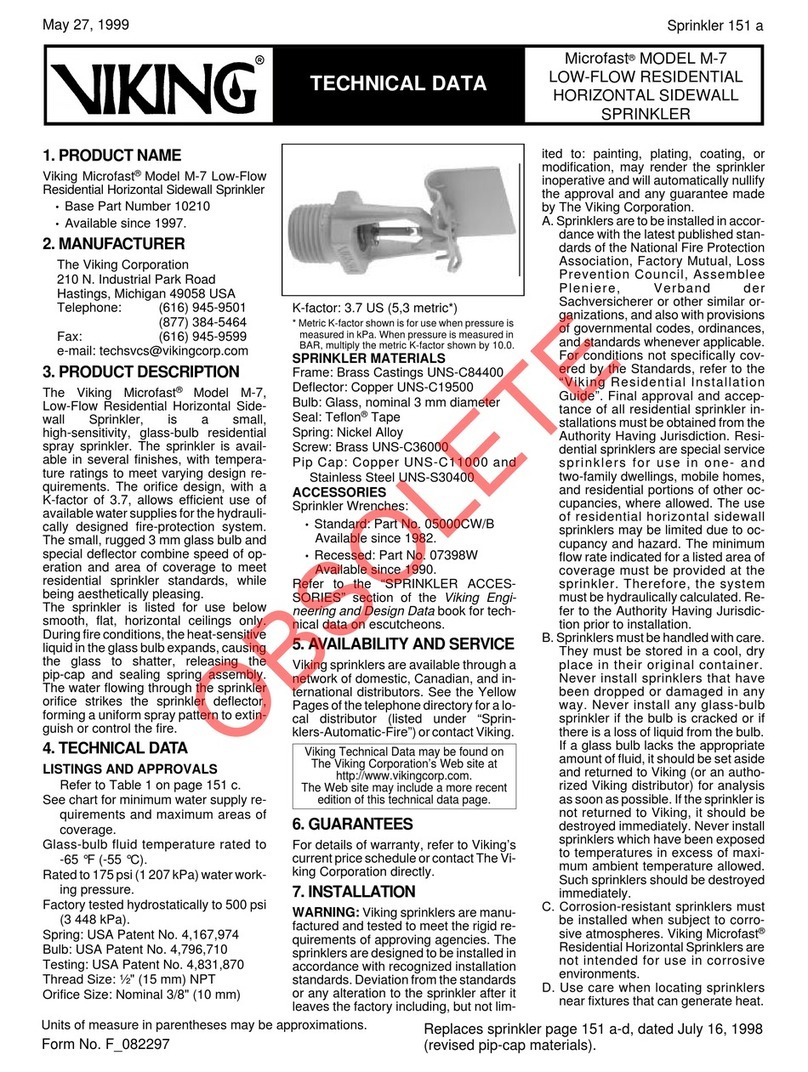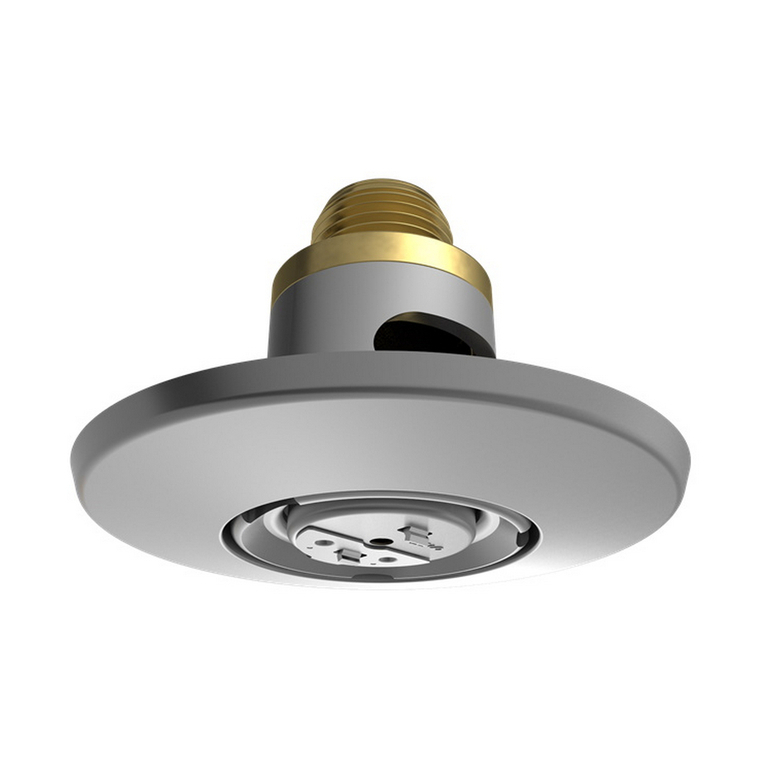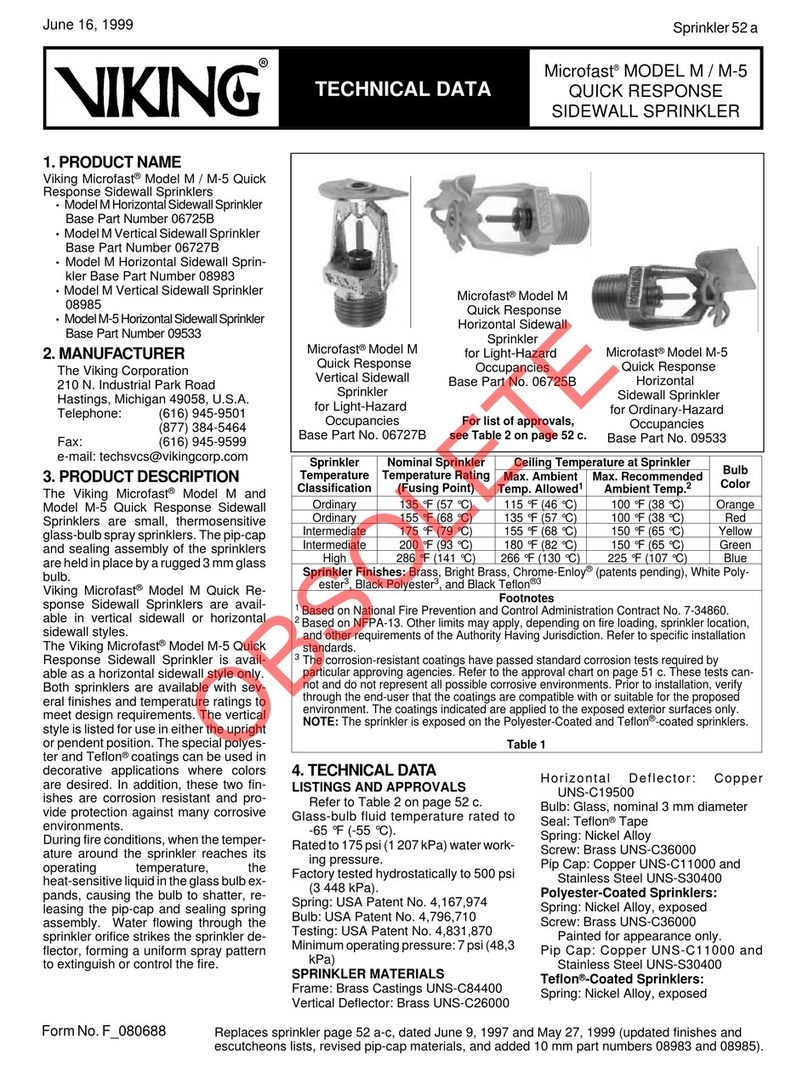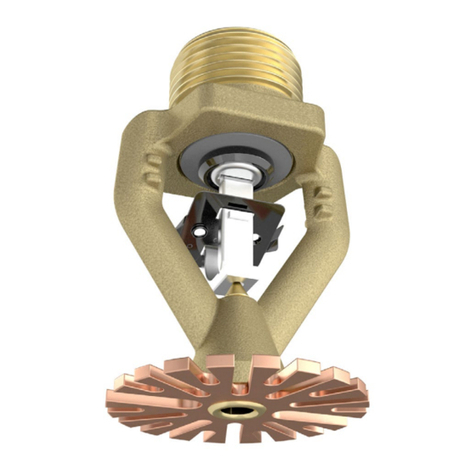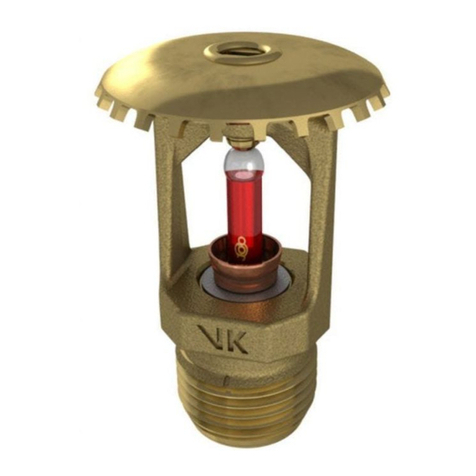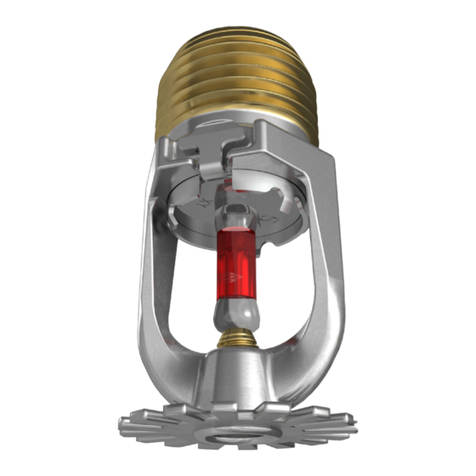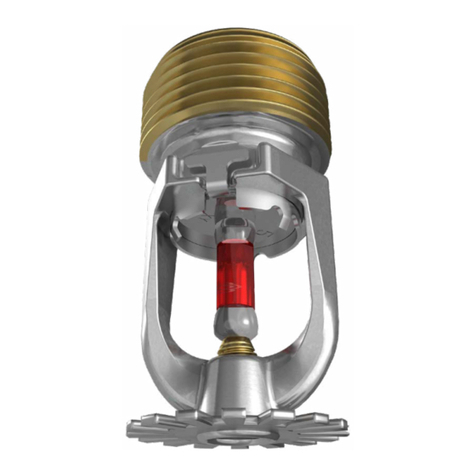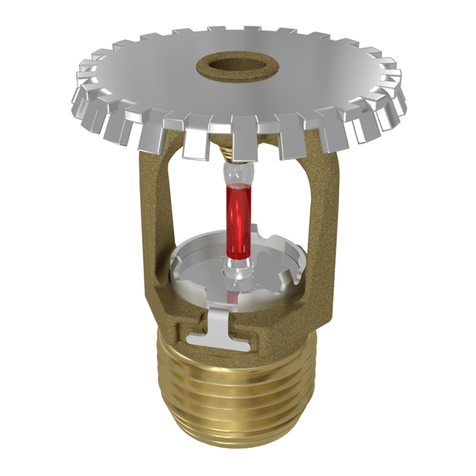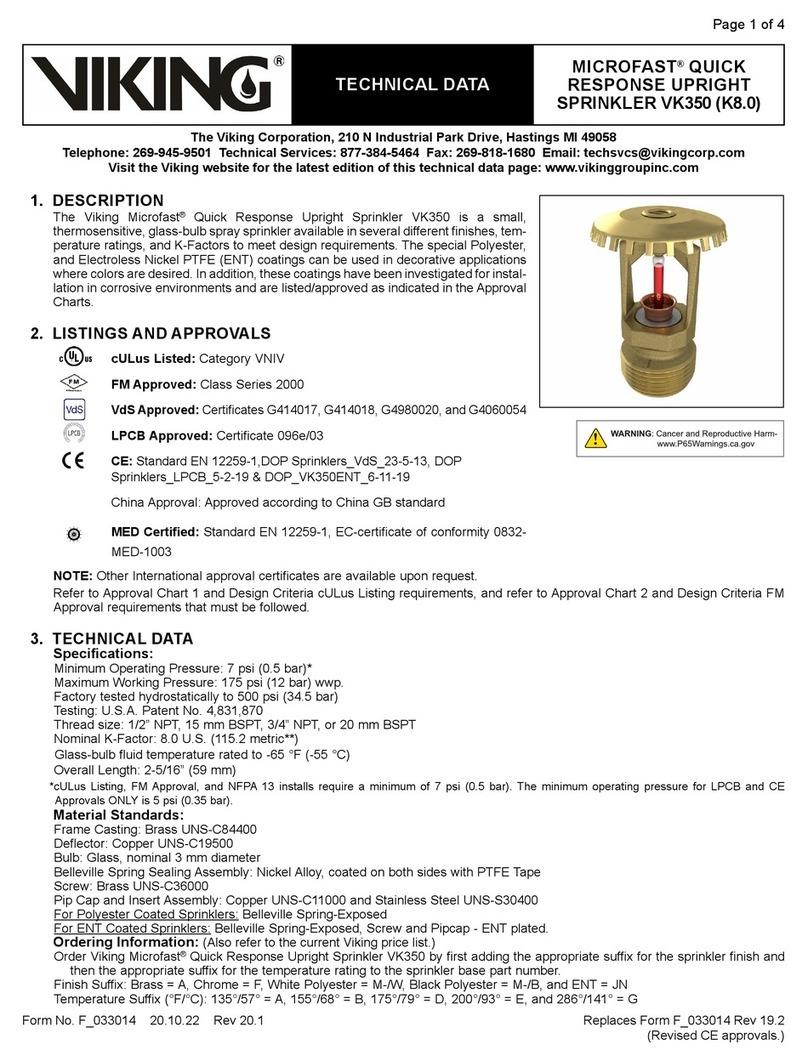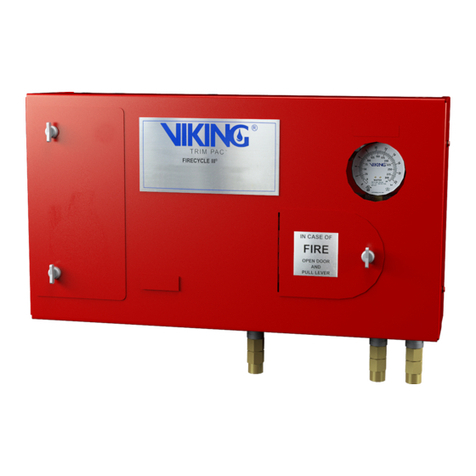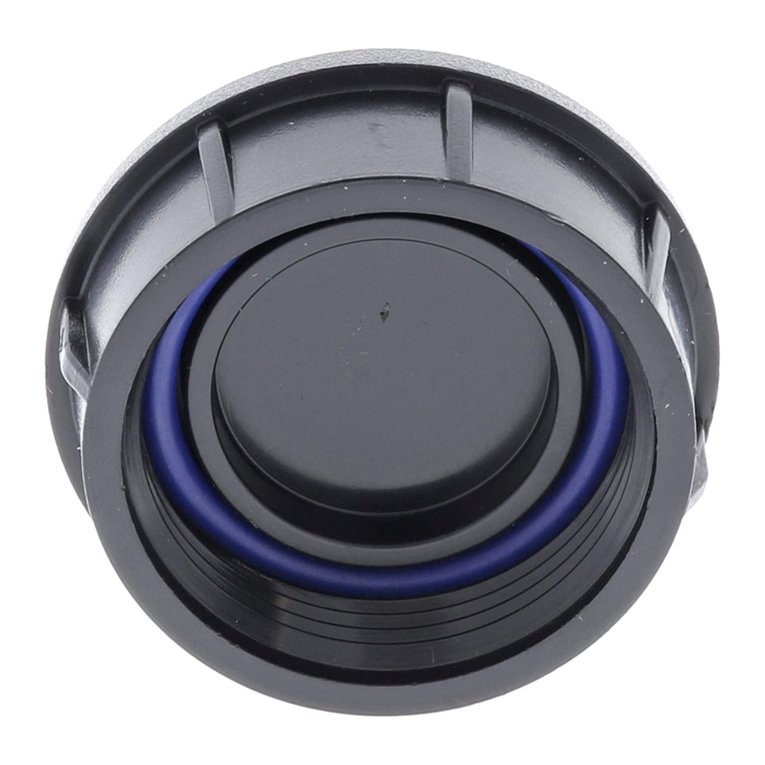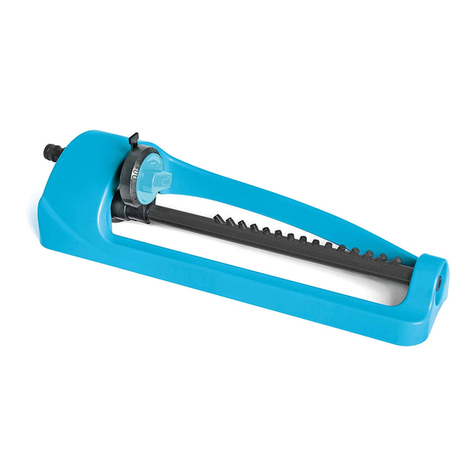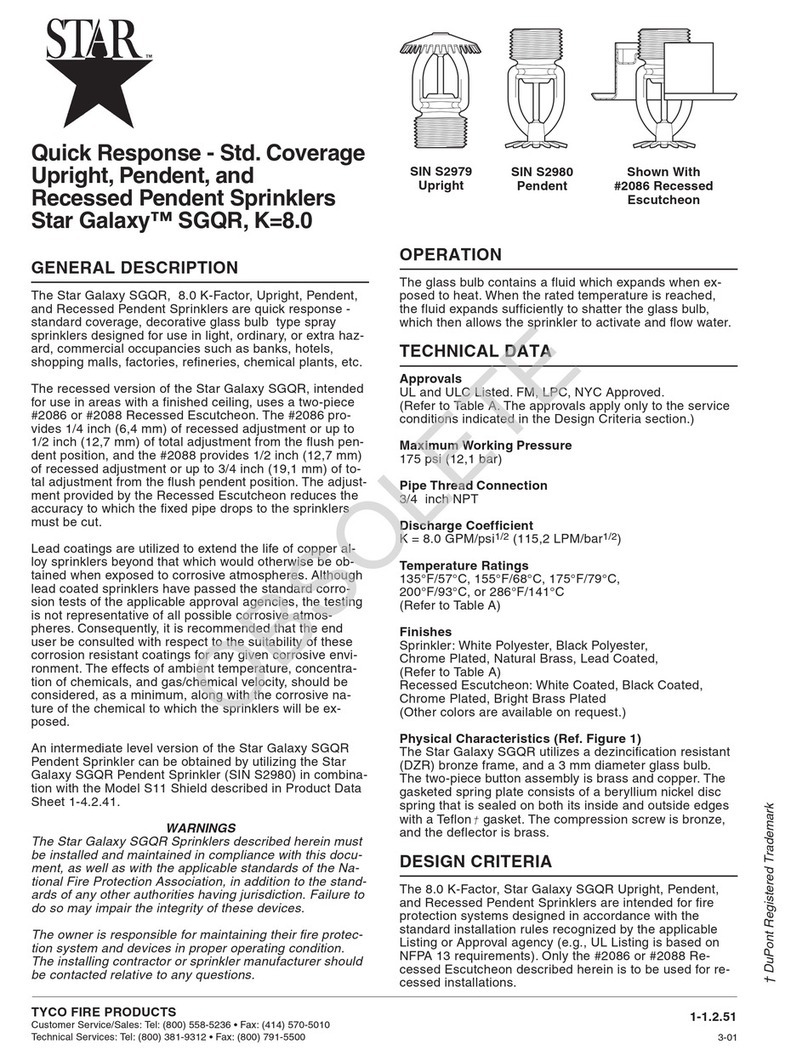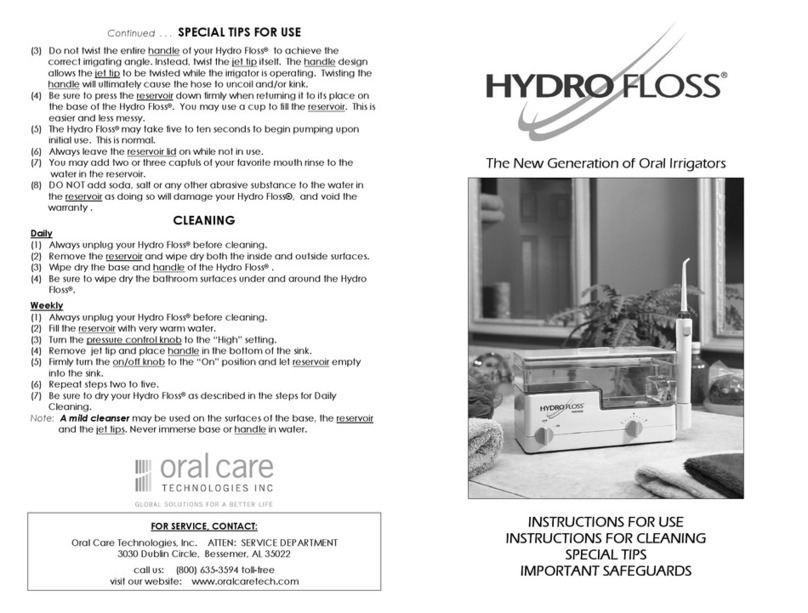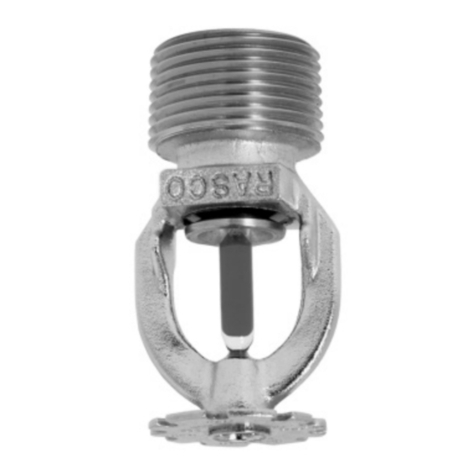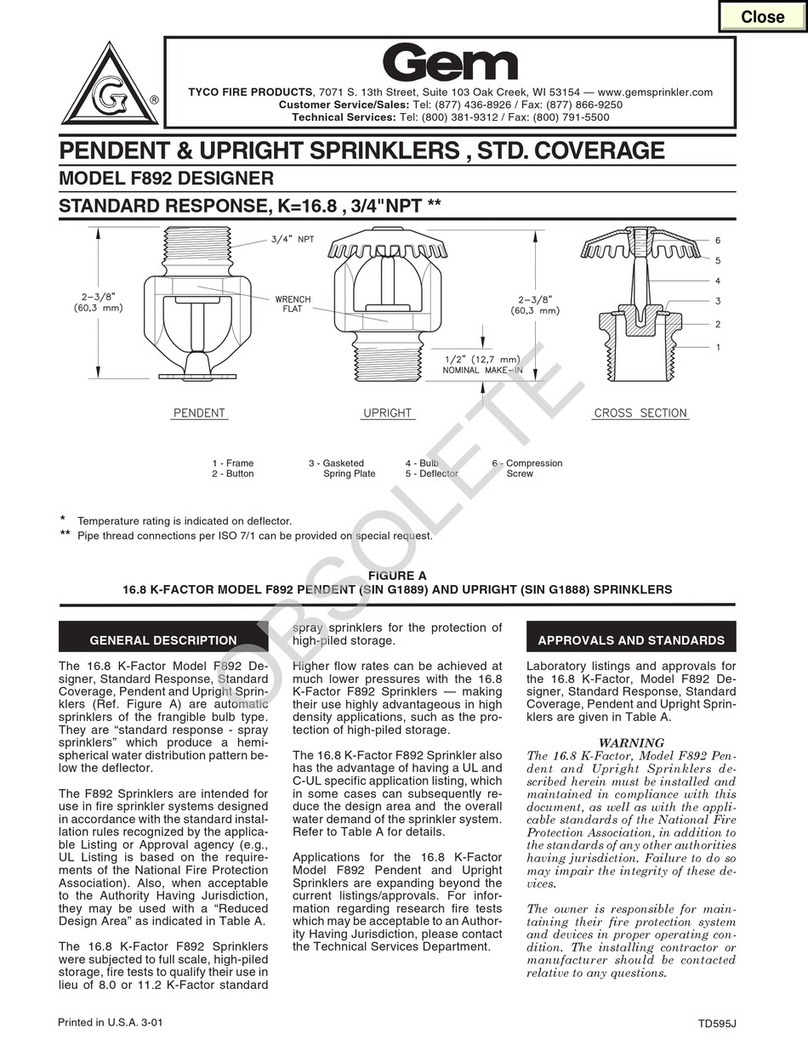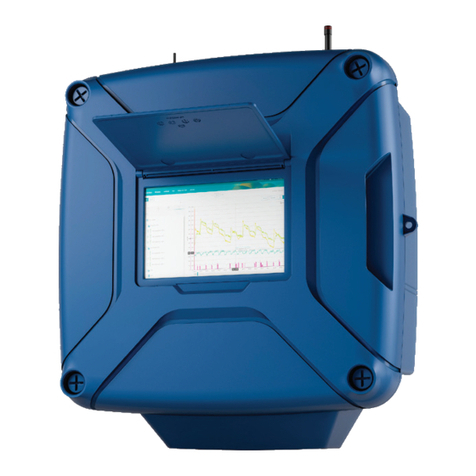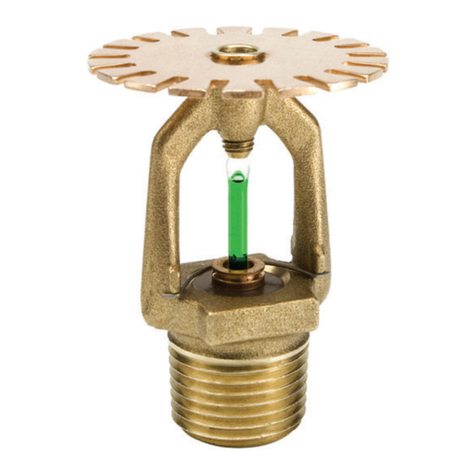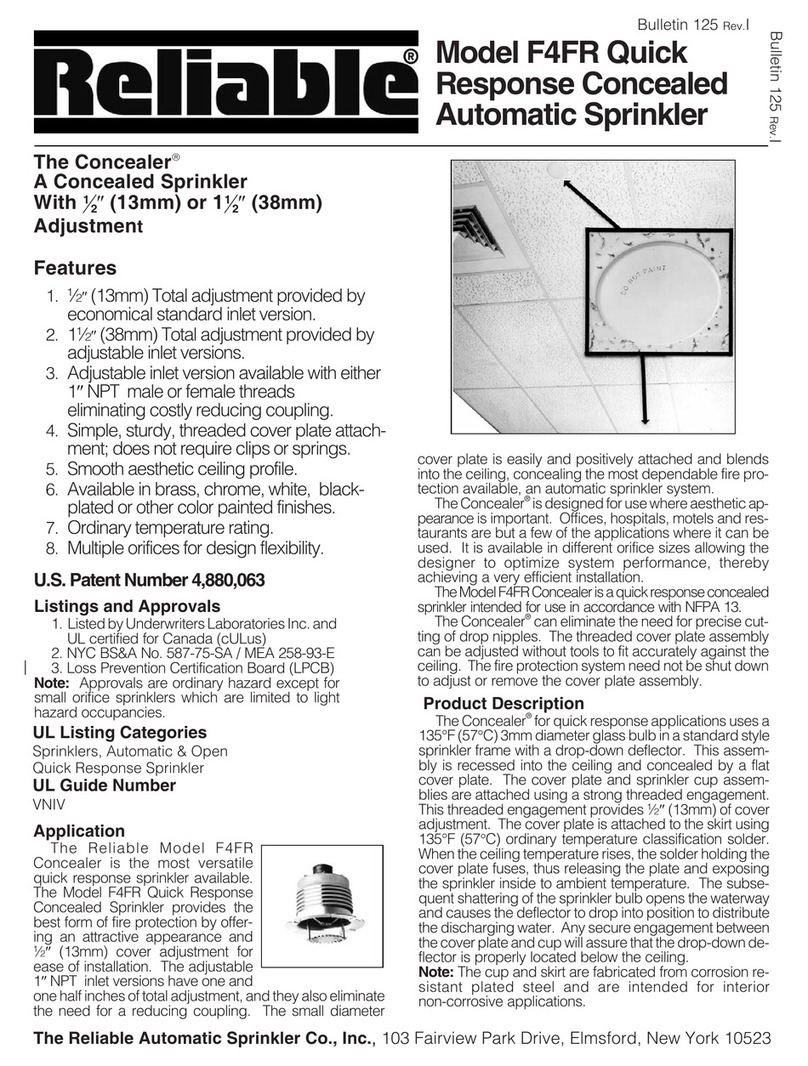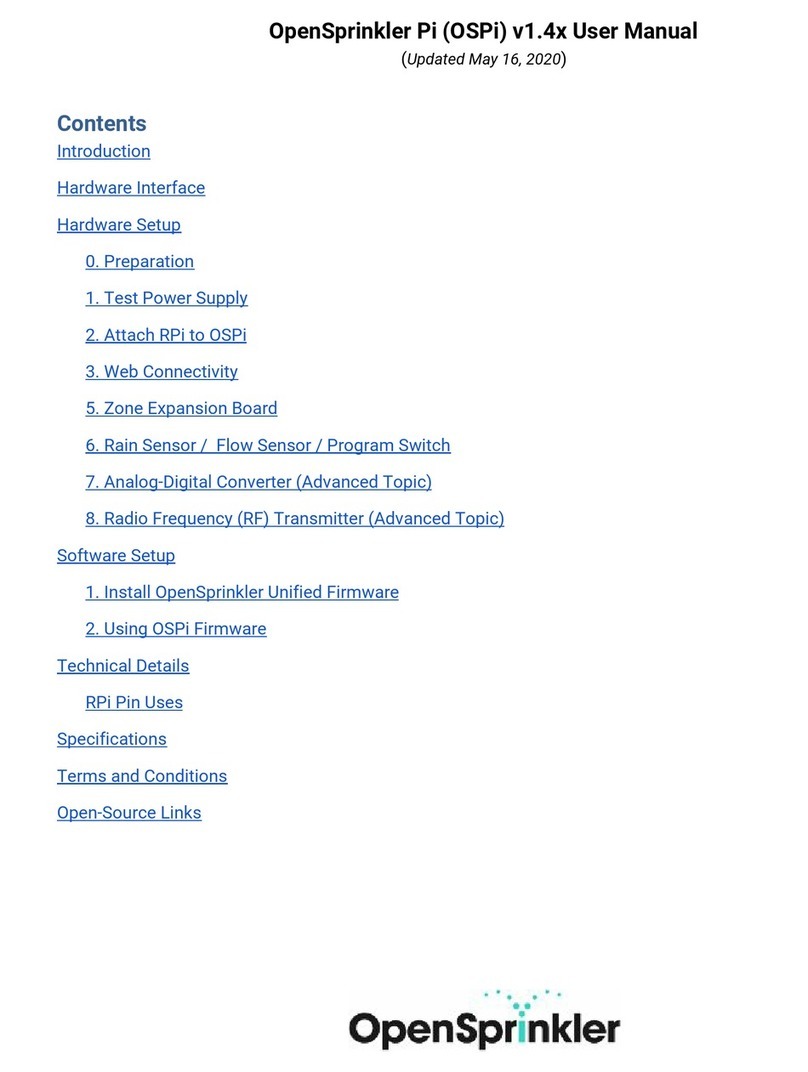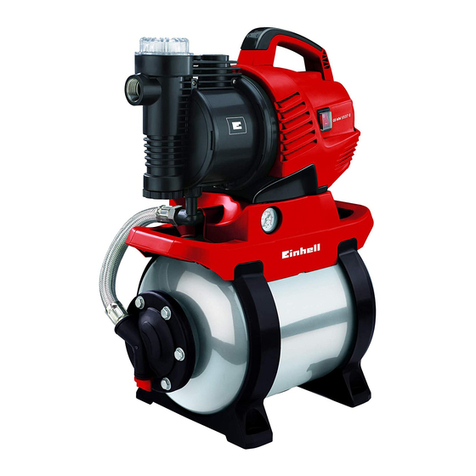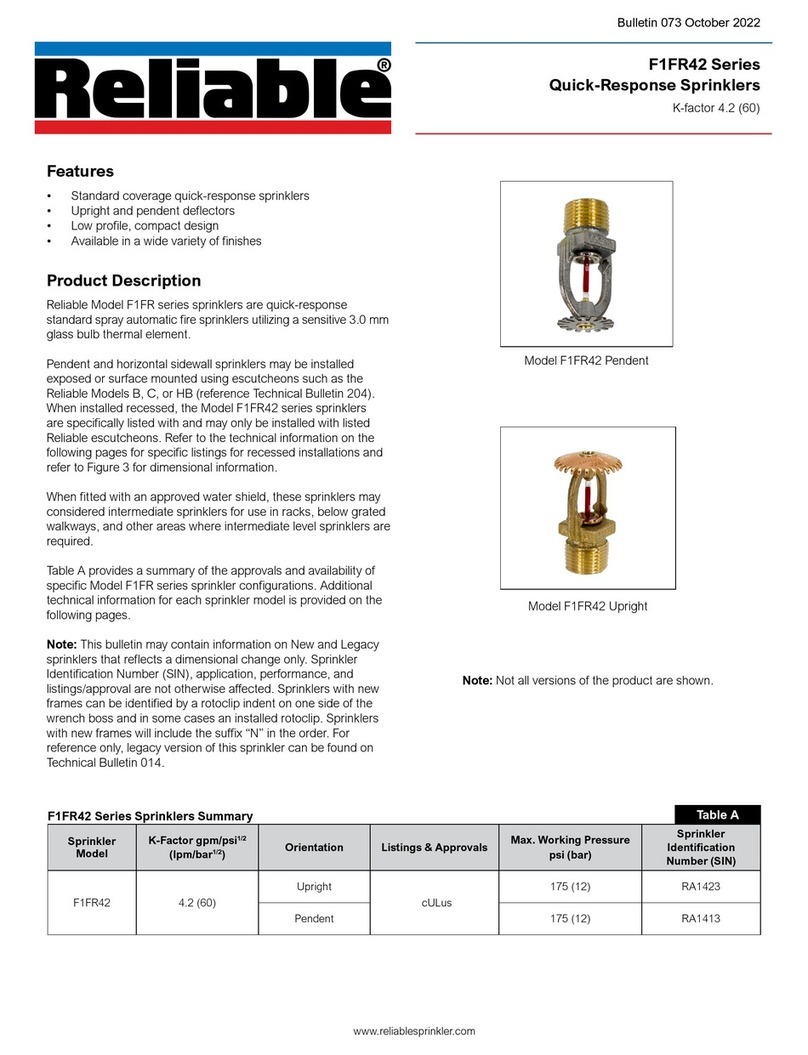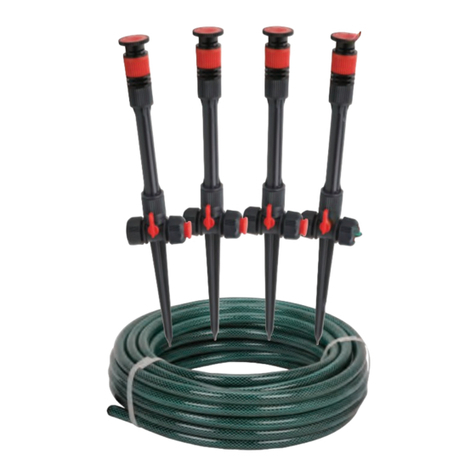
Installation Wrench and facilitate in-
stallation of the escutcheon plate.
As the escutcheon plate is threaded
ontothesprinklerbody,thefourarms
of the lockring must fully engage with
theradialgroovesontheinside ofthe
escutcheonplate. Continueto thread
the escutcheon plate onto the sprin-
kler body until the plate’s flange fits
tightly against the surface of the ceil-
ing. Then, proceed to turn the es-
cutcheon plate another ½ turn clock-
wisetoensurethatitissecuredtothe
ceiling.
The arms of the lockring are angled
and designed to wedge into the
coined radial grooves on the inside
face of the escutcheon plate to keep
the escutcheon plate from being un-
screwed.Thus,anattempttoremove
the escutcheon plate after installa-
tion is prevented. DO NOT MODIFY
THE UNIT.
L. The retaining flange, located behind
the finished ceiling, must fit snug
against the inner surface of the ceil-
ing to prevent vertical movement of
theassembly. Use a 1/8" hex wrench
to tighten the retaining flange screw
and secure the assembly into place
to prevent it from being pulled
through the ceiling.
M. DISASSEMBLY: Refer to section 9.
MAINTENANCE, paragraph D. and
follow all warnings and instructions.
9. MAINTENANCE
(Refer to Figures 1, 2, and 3.)
NOTICE:The owner is responsible for
maintaining the fire protection system
and devices in proper operating condi-
tion. For minimum maintenance and in-
spection requirements, refer to the ap-
propriate National Fire Protection Asso-
ciation’s pamphlet that describes care
and maintenance of sprinkler systems.
In addition, the Authority Having Juris-
diction may have additional mainte-
nance requirements that must be fol-
lowed.
A.Thesprinklersmustbeinspectedona
regular basis for corrosion, mechani-
cal damage, obstructions, paint, etc.
The frequency of the inspections
may vary due to corrosive atmo-
spheres, water supplies, and activity
around the device.
B. Sprinklers that have been painted or
mechanically damaged must be re-
placed immediately. Sprinklers
showing signs of corrosion shall be
tested and/or replaced immediately
as required. Quick response sprin-
klers that are 20 years old shall be
tested and/or replaced as required.
Sprinklersthat haveoperated cannot
be reassembled or reused, but must
be replaced. When replacing sprin-
klers, use only new sprinklers.
C.Thesprinklerdischargepatterniscrit-
ical for proper fire protection. Noth-
ing should be hung from the sprin-
kler, attached to it, or otherwise ob-
struct the discharge pattern. All ob-
structions must be immediately re-
moved or, if necessary, additional
sprinklers installed.
D. When replacing existing sprinklers,
the system must be removed from
service. Refer to the appropriate
system description and/or valve
instructions. Prior to removing the
system from service, notify all
Authorities Having Jurisdiction.
Consideration should be given to
employment of a fire patrol in the
affected area.
DISASSEMBLY: There are two
methods of sprinkler disassembly. In
Method 1, the escutcheon plate and
lockring are removed first, and then
the remaining sprinkler components
can be removed without being
destroyed. The second method of
disassembly results in complete
destruction of the unit.
Disassembly Method 1:
1. Remove the system from service,
drain all water, and relieve all pres-
sure on the piping.
2. Use a drill (not available from Viking)
sized appropriately for use with a
spanner wrench (see step 3) to
make two holes through two oppo-
site indentations on the face of the
escutcheon plate.
3. Use a ½" C-C spanner wrench (Vi-
king P/N 10729) to unthread the es-
cutcheonplate by turningit counter-
clockwise.Make sure thatthe sprin-
kler body does not turn or loosen.
4. Remove the lockring from the sprin-
kler body.
5. Place a protective sprinkler shell
(from the spare sprinkler cabinet)
over the sprinkler to be removed.
6. With the protective shell over the
sprinkler, place the special Flush/
Concealed Sprinkler Wrench over
theunit and turnit counterclockwise
to carefully unthread the sprinkler
body from the reducing coupling.
7. Install the new unit using the
Flush/ConcealedSprinklerWrench.
Care must be taken to ensure that
the replacement sprinkler is the
proper model and style, with the ap-
propriate orifice size, temperature
rating, and response characteris-
tics. A fully stocked spare sprinkler
cabinet should be provided for this
purpose. (Stock of spare lockrings
and escutcheon plates should be
availableinthe sparesprinklercabi-
net in addition to the spare sprinkler
heads.)
8.Placethe systemback in serviceand
secure all valves. Check the re-
placed sprinklers and repair all
leaks.
Disassembly Method 2:
1. Remove the system from service,
drain all water, and relieve all pres-
sure on the piping.
2. Disassembleandremovethefusible
element,andbendthedeflectorand
sealingassembly to expose the wa-
terway of the sprinkler.
3. Insert an easy-out screw extractor
(Trade No. 6) into the waterway.
Turnthe easy-outcounterclockwise
with a wrench to remove the sprin-
kler assembly from the reducing
coupling.
4. Install the new unit using the Flush/
Concealed Sprinkler Wrench. Care
must be taken to ensure that the re-
placement sprinkler is the proper
model and style, with the appropri-
ate orifice size, temperature rating,
and response characteristics. A
fullystocked sparesprinklercabinet
shouldbe provided forthis purpose.
(Stock of spare lockrings and es-
cutcheonplatesshould beavailable
in the spare sprinkler cabinet in ad-
ditiontothesparesprinklerheads.)
5.Placethe systemback in serviceand
secure all valves. Check the re-
placed sprinklers and repair all
leaks.
E. Sprinkler systems that have been
subject to a fire must be returned to
service as soon as possible. The en-
tire system must be inspected for
damage and repaired or replaced as
necessary.Sprinklersthathavebeen
exposed to corrosive products of
combustion or high ambient temper-
atures,buthavenotoperated,should
be replaced. Refer to the Authority
Having Jurisdiction for minimum re-
placement requirements.
T
TECHNICAL DATA
April 22, 1999
Sprinkler 60 d
MODEL HQR-2 INSTITUTIONAL
QUICK RESPONSE FLUSH
PENDENT SPRINKLER
Form No. F_100998
Replaces page 60 a-d, dated March 18, 1999
(Revised paragraph 9 MAINTENANCE).
NOTE:This method of disassembly
results in damage to the
escutcheon plate and lockring,
and they cannot be reused
NOTE:This method of disassembly
results in complete destruction
of the unit. None of the sprinkler
components may be reused.

